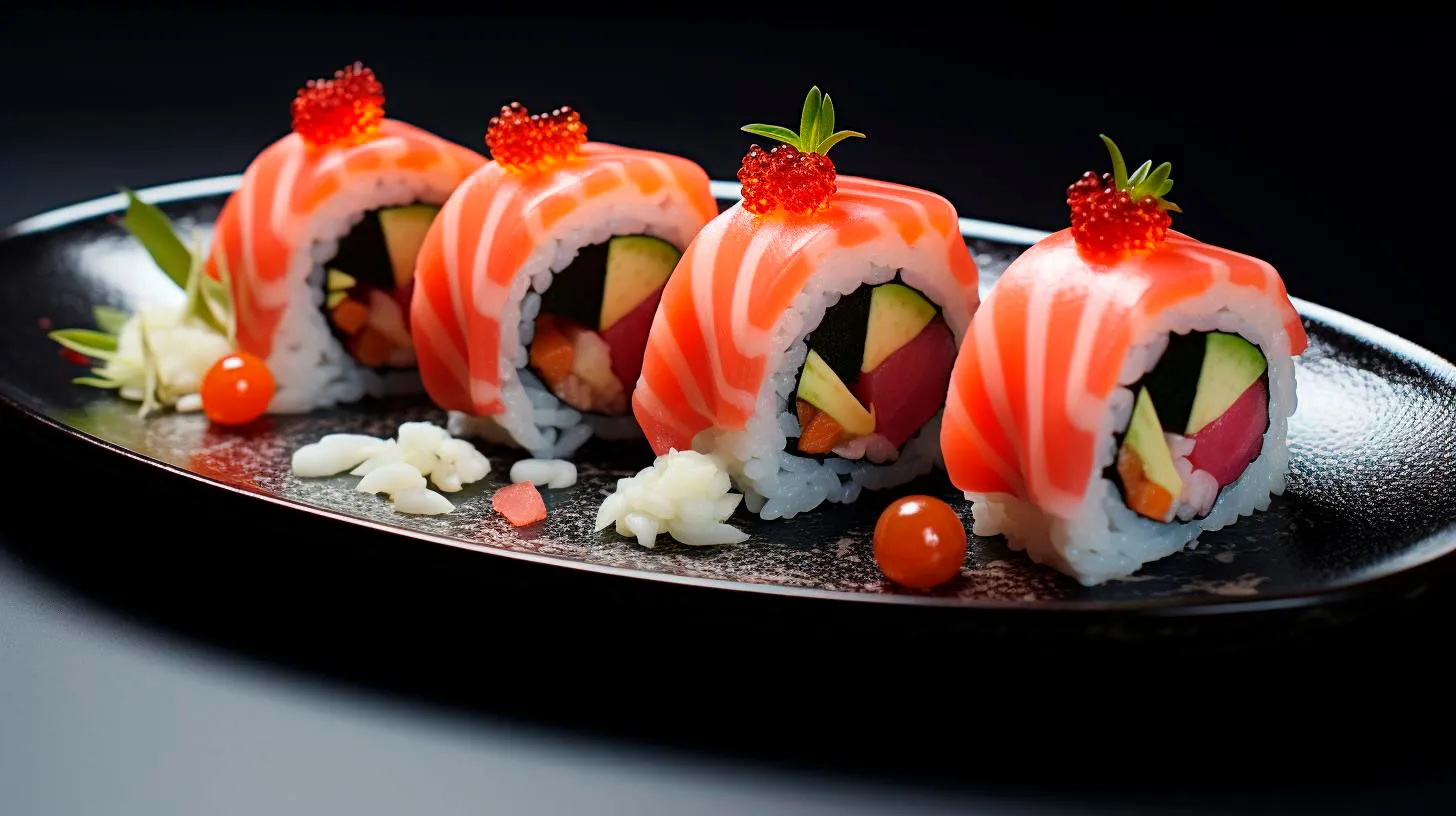The Art of Tasting Sushi: Unlocking Hidden Flavors
There is an art to tasting sushi that can unlock hidden flavors and elevate your dining experience to new heights. In this article, we will explore the secrets of tasting sushi and discover how to truly appreciate its complex flavors.
The Importance of Sushi Tasting
When it comes to sushi, tasting it properly is crucial to truly understanding and appreciating its flavors. Much like a fine wine, sushi has a wide range of flavors and textures that can be missed if not tasted mindfully. By taking the time to explore and savor each bite, you can uncover the subtle nuances and hidden flavors that make sushi so unique.
How to Taste Sushi
Tasting sushi goes beyond simply popping a piece into your mouth and swallowing it. To fully experience the flavors, follow these steps:
- Observe: Take a moment to appreciate the presentation of the sushi. Notice the colors, textures, and overall appearance of the dish.
- Smell: Bring the sushi close to your nose and inhale gently. This will allow you to pick up on any aromatic notes that can enhance your tasting experience.
- Take a small bite: Place the sushi gently on your tongue and let it sit for a moment. Allow your taste buds to become acquainted with the flavors.
- Chew slowly: As you begin to chew, pay attention to the textures and flavors that emerge. Notice any changes in taste or texture as you continue to chew.
- Reflect: After swallowing, take a moment to reflect on the taste and overall experience. Note any lingering flavors or sensations.
By following these steps, you can fully immerse yourself in the art of tasting sushi and unlock the hidden flavors that lie within.
The Key to Tasting Sushi: Umami
One of the key elements of sushi that sets it apart from other cuisines is its focus on umami, the fifth taste sensation alongside sweet, sour, salty, and bitter. Umami is often described as savory, rich, and satisfying. It is the umami flavor that makes sushi so addictive and enjoyable to eat.
When tasting sushi, pay attention to the umami flavor and how it interacts with other tastes. The balance of flavors in sushi is carefully crafted, and understanding umami can help you appreciate the skill and expertise of the sushi chef.
Unlocking Hidden Flavors
Now that you understand the importance of tasting sushi and the role of umami, let’s explore how to unlock hidden flavors in different types of sushi:
Nigiri Sushi: Nigiri sushi consists of a slice of raw fish or shellfish atop a small mound of vinegared rice. To fully experience the flavors, try the following:
- Start with mild fish like flounder or snapper and progress to more robust flavors like fatty tuna or salmon.
- Experiment with different dipping sauces like soy sauce, wasabi, or pickled ginger to enhance the flavors.
Sashimi: Sashimi is thinly sliced raw fish or seafood served without rice. To unlock hidden flavors:
- Try sashimi with a touch of soy sauce and wasabi to enhance the flavors.
- Pair different sashimi varieties with specific condiments to bring out their unique taste profiles.
Maki Rolls: Maki rolls are made by rolling seafood, vegetables, and rice in a sheet of seaweed. To taste the hidden flavors:
- Experiment with different combinations of fillings to see how they complement each other.
- Try dipping the maki rolls in soy sauce or adding a touch of wasabi for an extra kick.
Key Takeaways
Tasting sushi is an art that requires mindfulness and appreciation for the flavors. By following the steps to taste sushi properly and understanding the importance of umami, you can unlock hidden flavors and elevate your sushi experience. Remember these key takeaways:
- Observe, smell, take small bites, chew slowly, and reflect to fully appreciate the flavors of sushi.
- Understand the role of umami in sushi and how it enhances the overall taste.
- Experiment with different types of sushi, dipping sauces, and condiments to unlock hidden flavors.
So, the next time you enjoy a plate of sushi, savor each piece mindfully. Explore the flavors, textures, and complexities that make sushi a true culinary masterpiece. Happy tasting!
Enhancing Your Sushi Experience: Unveiling the Secrets of Umami
But have you ever wondered what makes sushi so irresistibly delicious? The secret lies in umami – the fifth taste that adds depth and complexity to every sushi roll.
Understanding Umami – The Fifth Taste
Umami is a term that originated in Japan and refers to a savory or meaty taste. Discovered by Japanese scientist Kikunae Ikeda in 1908, umami has since been recognized as the fifth taste, alongside sweet, sour, salty, and bitter. It is an essential component of many Japanese dishes, including sushi. In simple terms, umami is what makes sushi taste so incredibly satisfying.
The umami taste is attributed to the presence of glutamate, an amino acid that naturally occurs in certain ingredients. When glutamate combines with certain other compounds, such as ribonucleotides, it creates a synergy that intensifies the umami flavor. This tantalizing taste sensation can be found in several key ingredients used in sushi, such as seaweed, soy sauce, and fish.
Unleashing Umami in Your Sushi
To enhance your sushi experience and fully enjoy the umami taste, there are several tips and tricks you can follow. By incorporating these elements into your sushi preparation, you can take your culinary skills to the next level and impress your friends and family with an unforgettable umami-packed meal. Here’s how you can do it:
1. Opt for High-Quality Ingredients
- Choose fresh, high-quality fish with vibrant colors and firm textures.
- Use sushi-grade fish, which is specifically processed and stored to ensure optimal taste and safety.
- Select high-grade, short-grain sushi rice known for its stickiness and ability to hold flavors.
2. Perfectly Season Your Rice
- Follow traditional sushi rice preparation methods, such as rinsing the rice and cooking it with the ideal water-to-rice ratio.
- Add sushi vinegar, made from rice vinegar, sugar, and salt, to impart a delicious tanginess to the rice.
- Distribute the vinegar evenly throughout the rice using a cutting and folding motion to ensure every grain is flavored.
3. Include Umami-Rich Ingredients
- Introduce umami flavors through the use of kombu (seaweed), which is rich in glutamate.
- Include soy sauce, which contains high levels of glutamate and enhances the umami taste of other ingredients.
- Experiment with different fish varieties, such as fatty tuna, mackerel, or salmon, which are rich in umami compounds.
4. Explore Umami-Boosting Condiments
- Accompany your sushi with wasabi, a spicy condiment that stimulates the taste buds and amplifies umami.
- Try pickled ginger, which cleanses the palate and prepares it for the next flavorful bite.
- Include toppings like sesame seeds or green onions, which provide additional layers of taste and texture.
The Key Takeaways
By understanding and embracing the concept of umami, you can elevate your sushi experience to new heights. Remember these key takeaways to unleash the full potential of umami in your sushi creations:
- Umami is the fifth taste and adds depth and complexity to sushi.
- Incorporate high-quality ingredients and sushi-grade fish for the best results.
- Perfectly season your rice with sushi vinegar to enhance the flavor.
- Introduce umami-rich ingredients like seaweed and soy sauce.
- Experiment with umami-boosting condiments such as wasabi and pickled ginger.
With these tips in your culinary arsenal, you’ll be able to create sushi dishes bursting with umami goodness. So, gather your ingredients, roll up your sleeves, and embark on a sushi adventure that will leave your taste buds craving for more!
Dipping Deeper: Unearthing Soy Sauce Substitutes for Sushi Lovers
In this article, we will dive deep into the world of soy sauce substitutes and explore some equally tantalizing options to enhance your sushi experience.
The Essence of Soy Sauce
Soy sauce, also known as shoyu in Japan, is made from a fermented mixture of soybeans, wheat, salt, and water. Rich in umami flavor, it provides the perfect balance to the delicate taste of sushi rice and fresh fish. But fret not, for there are many alternatives that can replicate the essence of soy sauce!
1. Tamari Sauce
If you are looking for a gluten-free alternative to soy sauce, tamari sauce is your best bet. Made from fermented soybeans without the addition of wheat, it has a slightly darker color and a more robust flavor. Here are some key points about tamari sauce:
- It is a gluten-free option for those with dietary restrictions.
- With its rich and intense flavor, a little goes a long way.
- Tamari sauce works well as a dipping sauce or as an ingredient in sushi marinades.
2. Coconut Aminos
For those who prefer a soy-free and gluten-free option, coconut aminos can be an excellent choice. Made from the sap of coconut blossoms, it offers a mildly sweet and savory flavor. Consider these advantages of coconut aminos:
- It is a suitable option for people with soy or gluten intolerances.
- Coconut aminos provide a unique flavor profile, adding a touch of sweetness to your sushi.
- It contains essential amino acids, vitamins, and minerals.
3. Ponzu Sauce
If you are craving a citrusy twist to complement your sushi, ponzu sauce is an excellent alternative to soy sauce. This Japanese condiment is made by combining citrus juice, soy sauce, and vinegar. Some notable features of ponzu sauce are:
- It brings a refreshing and tangy flavor to sushi.
- Ponzu sauce can be used as both a dipping sauce and a marinade.
- It pairs exceptionally well with seafood, enhancing the natural flavors.
4. Miso Paste
For those who prefer a thicker and more concentrated option, miso paste can be a fantastic soy sauce substitute. Made from fermented soybeans, it offers a complex flavor profile with a hint of saltiness. Here are some noteworthy facts about miso paste:
- It adds depth and complexity to sushi dishes, especially when used in marinades or dressings.
- Miso paste is a good source of protein, vitamins, and minerals.
- There are different types of miso with varying levels of saltiness and sweetness.
Key Takeaways
Sushi lovers need not despair if soy sauce is unavailable. There are numerous alternatives to enhance your sushi experience. Remember these key takeaways:
- Tamari sauce, a gluten-free option, provides a robust flavor to your sushi.
- Coconut aminos, a soy-free and gluten-free alternative, offer a mildly sweet and savory taste.
- Ponzu sauce brings a tangy and citrusy twist to complement your favorite sushi rolls.
- Miso paste adds depth and complexity to sushi, with its concentrated flavor.
So, the next time you find yourself craving sushi without soy sauce, don’t hesitate to explore these enticing substitutes. Each option brings a unique flavor to your dining experience, allowing you to savor the art of sushi without compromising on taste or dietary preferences. Happy dipping!
Exploring Beyond Soy Sauce: Alternative Condiments for Sushi
In this article, we will explore different condiments that can elevate your sushi experience to a whole new level.
The Role of Condiments in Sushi
Before we delve into the alternatives, let’s understand the role that condiments play in sushi. While sushi is crafted to perfection by skilled chefs, condiments add an additional burst of flavor to each bite. The traditional soy sauce, made from fermented soybeans, provides a savory and salty taste that complements the mild flavors of the sushi. However, there is a whole world of condiments waiting to be explored.
Alternative Condiments for Sushi
1. Ponzu Sauce
A tangy and citrusy sauce, ponzu is made from soy sauce, lemon juice, vinegar, and seasonings. It imparts a bright and refreshing flavor to the sushi, enhancing the natural taste of the fish. Ponzu sauce contains essential oils, which aid digestion and provide a myriad of health benefits. Key Takeaway: Ponzu sauce adds a zesty twist to your sushi and promotes digestive health.
2. Wasabi
Wasabi, known for its distinctive green color, delivers a pungent and spicy kick. Made from the root of the Japanese horseradish, it offers a strong flavor that can clear your sinuses. Many sushi enthusiasts enjoy mixing wasabi with soy sauce to create a spicy, umami-infused dip. Key Takeaway: Wasabi provides a fiery sensation that enhances the overall sushi experience.
3. Goma Dare (Sesame Sauce)
Sesame sauce, also known as goma dare, adds a rich and nutty flavor to sushi. Made from ground sesame seeds, soy sauce, and seasonings, this condiment offers a creamy texture that complements both sushi and sashimi. Sesame seeds are an excellent source of essential minerals and healthy fats. Key Takeaway: Goma dare elevates sushi with a creamy, nutty taste and provides nutritional benefits.
4. Yuzu Kosho
A popular condiment in Japan, yuzu kosho is made from fermented yuzu zest, chili peppers, and salt. It provides a unique blend of citrusy, peppery, and spicy flavors. Yuzu kosho pairs exceptionally well with fatty fish like tuna or mackerel, balancing the richness with its tangy zest. Key Takeaway: Yuzu kosho adds complexity and a tangy twist to your sushi rolls.
5. Tamari
Similar to soy sauce, tamari is a gluten-free alternative made from fermented soybeans. It has a slightly thicker consistency and a richer, milder taste compared to traditional soy sauce. With its deep umami flavor, tamari enhances the overall taste of sushi without overpowering it. Key Takeaway: Tamari is an excellent choice for those with gluten sensitivities and provides a more nuanced flavor for your sushi.
Increasing Your Sushi Experience
Next time you indulge in a plate of sushi, consider exploring these alternative condiments to elevate your dining experience. Venture beyond the traditional soy sauce and experiment with new flavors that complement the delicate flavors of your favorite sushi rolls. Remember, variety is the key to enhancing your sushi experience!
By incorporating ponzu sauce, wasabi, goma dare, yuzu kosho, or tamari, you can unlock a whole new world of flavors that will make your sushi taste even more extraordinary. So, what are you waiting for? Take a leap and explore the diverse landscape of sushi condiments.


